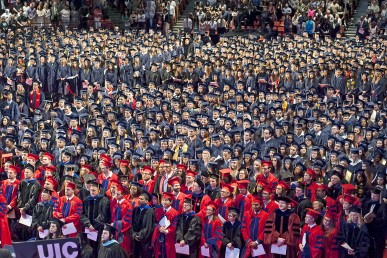UIC’s graduation rate, Hispanic enrollment climb
Graduation rates for students at the University of Illinois at Chicago continue to rise, while the student body remains highly diverse, with Latinos now accounting for over a quarter of the undergraduates — the threshold to qualify for designation as a Hispanic-Serving Institution by the U.S. Education Department.
The six-year graduation rate for the full-time freshmen who entered UIC in fall 2008 is 60 percent, up three percentage points from the year before. The five-year graduation rate for the new transfers who entered in fall 2009 also increased three points, to 77 percent.
Within the transfer group of 2009, African-American students registered the largest graduation-rate increase, up 18 percentage points, to 79 percent. Full-time Hispanic freshmen who entered in 2008 attained a 56 percent graduation rate, an increase of seven points.
Campus officials point to several factors that underlie a long-term trend to higher graduation rates at UIC.
As the most recent cohort was entering six years ago, “we began to take a holistic view of applicants and look at the factors most likely to indicate a student is ready for college and can do well,” said Emanuel Pollack, interim vice provost for undergraduate affairs.
“For example, rather than focusing on the composite ACT score (of four tests), we looked at the sub-scores in English and math as the most predictive of academic success,” Pollack said.
“The growing reputation of UIC has also improved our standing in competition for the better-prepared high school student,” he said.
Campus leaders are hoping to raise graduation rates even higher. Building on the improvement made over the last decade, a more recent Student Success Plan is “introducing new initiatives that promise to drive graduation rates even higher in coming years,” said UIC Chancellor Paula Allen-Meares.
New students now arrive with a better understanding of what to expect at UIC before they start classes, says Kevin Browne, vice provost for academic and enrollment services. Events such as the UIC Open House and deans’ receptions, along with campus tours and the new UIC Visitors Center, give prospective students a clearer picture of academic life at UIC.
“Your first day at college shouldn’t be your first day on campus,” Browne said. A preliminary visit allows prospective students “to see what the UIC experience is about, and what their four years at UIC will be like.”
The fall 2014 10th-day enrollment statistics show the total student population at UIC remained relatively unchanged with 27,563 students, a decrease of 26 from 2013’s record enrollment.
For the 2014-2015 academic year, the UIC student body comprises 16,707 undergraduates, 7,975 graduate students and 2,881 professional students. Professional student enrollment represents a record, while the undergraduate total decreased by 47 and the graduate total dropped by 211.
“We were up in applications, there’s more diversity, and students are applying from further and further afield. Our numbers in Chicago continue to be very strong,” Browne said.
According to the 10th-day census, the racial and ethnic distribution among all UIC students is 40.4 percent white, 18.9 percent Asian, 19.6 percent Hispanic/Latino and 7.9 percent African-American. For undergraduates, the figures are 35.8 percent white, 26.4 percent Hispanic/Latino, 22.7 percent Asian, and 7.9 percent African-American.
The 2.7 percentage point growth over 2013 for Hispanic/Latino undergraduates will allow UIC to seek designation as a Hispanic-Serving Institution from the Education Department, making it eligible to receive federal grants for student support services, classroom equipment, construction or renovation, faculty development, tutoring and counseling, and other academic offerings. The campus will submit its application in the spring, along with data on affordability, graduation ratesand financial aid.
“It’s an important milestone, in that we’re providing access for a large number of Latino students in the Chicago metro area to get a higher education degree,” said Tyrone Forman, vice provost for diversity. “But more important than being designated as a Hispanic-serving institution is that we make sure we support the students once they’re here.”
UIC was designated an Asian American and Native American Pacific Islander-Serving Institution in 2010.

